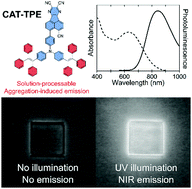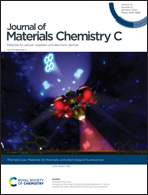A solution-processable near-infrared thermally activated delayed fluorescent dye with a fused aromatic acceptor and aggregation induced emission behavior†
Abstract
The unique synergy of properties offered by an efficient and processable near-infrared thermally activated delayed fluorescent (NIR TADF) dye could be transformative across research fields. Here, a solution-processable NIR TADF material is demonstrated (CAT-TPE). Good solubility is achieved through the use of a new tetraphenylethylene (TPE)-based triphenylamine electron donor. TADF is confirmed through variable temperature time-resolved measurements at a peak photoluminescence (PL) wavelength of 842 nm in a solution-processed film. An OLED with good roll-off characteristics for a solution-processed NIR TADF device is reported with electroluminescence λmax > 700 nm. CAT-TPE also demonstrates classic aggregation induced emission (AIE) behavior, being more emissive when aggregated than in solution with all PL > 700 nm. This work opens the door to the considerably enhanced structural diversity of solution-processable NIR TADF and will inform the design of future high efficiency AIE NIR TADF materials.

- This article is part of the themed collection: Materials for thermally activated delayed fluorescence and/or triplet fusion upconversion


 Please wait while we load your content...
Please wait while we load your content...